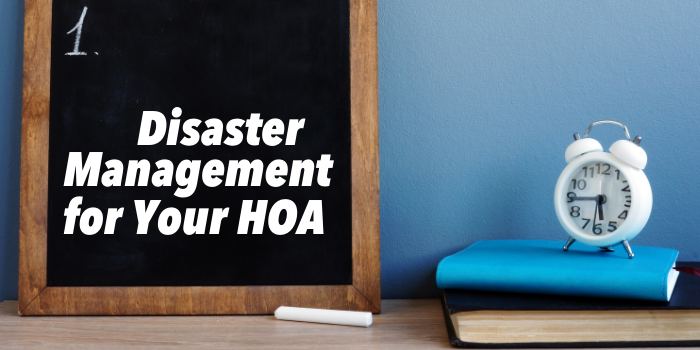How to Handle Disaster Management for Your HOA
Despite our best efforts, disasters are regular occurrences and are most often out of our control. Whether predicted or unexpected, natural or man-made, disasters can occur without warning, so it’s imperative to have a plan in place.
Here are a few fundamental tips for helping your HOA board prepare for a disaster in the community:
Take Special Consideration
From fires to earthquakes to violence, how a community responds to a disaster will differ and depends on several important aspects, including:
- Where your community is located will determine which types of disasters you may face and will serve as the framework for the preparation that needs to take place. Consider whether your location makes you more likely to experience disasters such as wildfire, earthquakes, floods, terrorism, etc.
- Age Demographics. Many HOAs appeal to a certain age demographic and will require adjustments in disaster management planning. For example, if your community has a large portion of elderly homeowners, you’ll need to consider potential limited mobility in the event of an evacuation. HOAs with young families will need to take into account the needs of small children in their disaster response.
- Be aware of the cultural background of your homeowners. Provide instructions for emergency procedures in any language that is predominately spoken to ensure that all community members understand them.
Have a Plan in Place
With consideration to geographical and cultural demographics, the board should prioritize creating a comprehensive disaster relief plan for the association. This plan will be key to reducing anxiety and increasing safety in the event of an emergency.
Your HOA’s disaster management plan should include the following items:
- Site Plan – This should include lift stations, debris staging areas, and the location of shut off valves and generators.
- Chain of Command – A clear plan for communications during and following a disaster is crucial and should include a first, second, and third point of contact, as well as alternative methods of communication.
- Evacuation Plan – In the event of an evacuation, homeowners need to know how and where to evacuate. Include a list of nearby shelters and generator-powered gas stations and/or grocery stores.
- Insurance Information – Your plan should include copies of all insurance policies as well as detailed information on how to file claims.
- Contact Information – List the contact information for board members, property managers, law firms, insurance agents, and debris removal vendors. It’s also a good idea to include other means of contact in the event that cell phone towers are inoperative.
- Meeting Place – Aside from technological communication, or in the event of a blackout, there should be a designated time and place that homeowners can meet to receive updates and announcements following a disaster. This could be a shared space such as the community pool, clubhouse, or park area.
- Photos – Include date stamped photos of common areas within the community.
- Owner List – An alphabetically organized list of homeowner contact information can make communication and identification easier.
Communicating the Plan
There are many ways to share your plan with homeowners. Consider hosting special preparedness meetings before the beginning of a dangerous season in your area. Publish your plan on your community website for easy access and include pertinent information throughout the year via monthly newsletters, social media posts, or eblasts.
Clearly communicating your disaster relief plan will not only ensure that homeowners are informed and prepared – it can also protect your HOA from liability should accidents occur as a result of a disaster.
As a board member, you already have a lot on your plate. Disasters are complex situations that require optimal planning and coordination to achieve the best possible outcome.
An HOA management company like Spectrum Association Management can compensate for any lack of experience in dealing with emergencies by helping to create a comprehensive plan that will minimize the impact of disaster on your community.







